Modern home exteriors can sometimes feel cold or impersonal, but wood accents provide the perfect remedy.
These natural elements introduce organic warmth that softens clean architectural lines while preserving contemporary aesthetics. The result is homes that feel both current and genuinely welcoming to residents and visitors alike.
Wood offers sustainable style options, particularly when using reclaimed materials that bring environmental benefits alongside distinctive character.
These weathered pieces add authentic history and unique grain patterns that new materials simply cannot match.
The natural texture creates visual interest and depth on flat exterior surfaces, with the interplay between smooth modern materials and organic wood grain adding sophisticated appeal.
This combination significantly improves curb presence while maintaining the clean lines that define contemporary architecture.
List of 13 Amazing Modern Wood Accents
Thirteen creative wood accent ideas that add natural warmth, texture, and visual interest to contemporary home exteriors.
1. Bold Contrast with Vertical & Charred Wood Siding
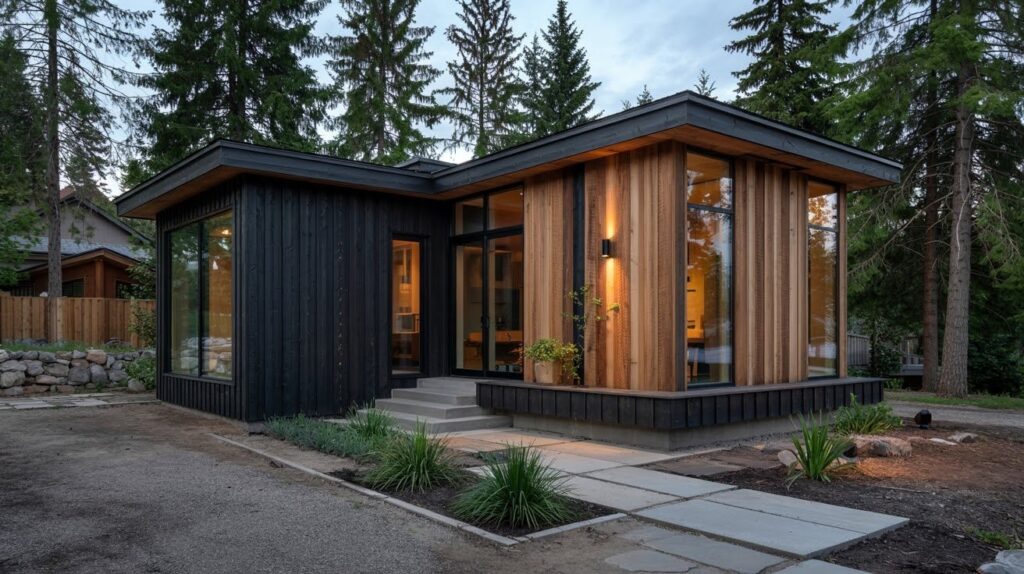
Vertical wood siding creates dynamic visual interest by contrasting with traditional horizontal lines found in most residential architecture.
This directional shift draws the eye upward, making homes appear taller and more imposing while adding contemporary flair to otherwise conventional structures.
The ancient Japanese technique of charring wood, known as Shou Sugi Ban, produces deeply blackened surfaces with unique texture and natural preservation properties.
When combined with reclaimed wood elements, this creates striking material contrasts that feel both timeless and thoroughly modern, offering durability alongside distinctive visual appeal.
2. Geometric Mountain Design in Vail, CO
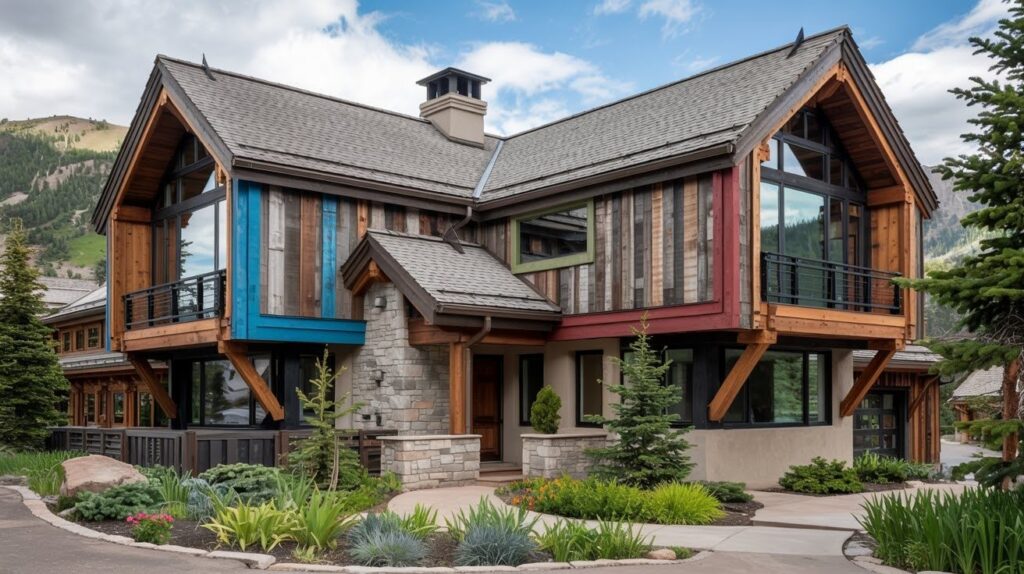
Mountain homes benefit from combining weathered grey reclaimed wood with freshly stained bright wood elements.
This approach creates visual depth while respecting the natural alpine environment, allowing homes to feel both integrated with their surroundings and architecturally distinct.
Strategic placement of colorful trim around wood accents adds personality without overwhelming the natural material palette.
Bright blues, deep greens, or warm oranges can highlight architectural features while maintaining the organic feel that wood naturally provides to mountain architecture.
3. Modern Home Addition with Character
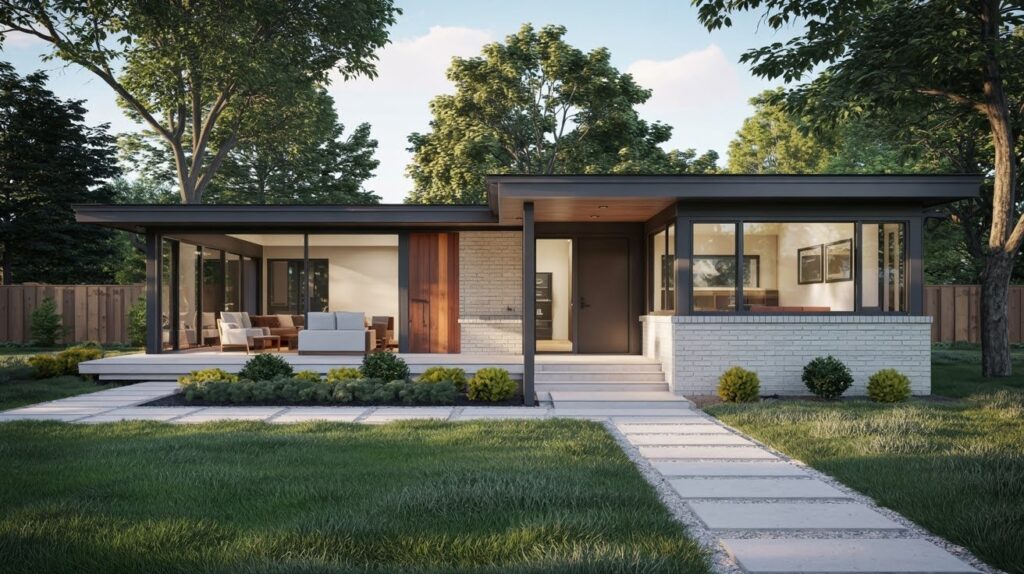
Home additions often struggle to integrate seamlessly with existing structures, but combining painted brick surfaces with reclaimed wood creates visual bridges between old and new construction.
This approach honors original architecture while clearly defining updated spaces through material contrast.
Mid-century modern homes sometimes feel cold due to their emphasis on geometric forms and industrial materials.
Adding warm wood accents to these structures softens harsh lines while preserving the clean aesthetic that defines this architectural period, creating homes that feel both authentic and livable.
4. Nature-Inspired Poolside Accent Wall

Poolside environments benefit enormously from wood accent walls that create intimate gathering spaces within larger outdoor areas.
These installations provide visual weight and natural texture that contrasts beautifully with water features and hardscape materials, establishing comfortable zones for relaxation and entertainment.
Selecting wood tones and textures that mirror surrounding natural elements creates seamless transitions between built and natural environments.
Weathered grays might echo coastal conditions, while warm browns complement desert landscapes, ensuring outdoor spaces feel integrated rather than imposed upon their settings.
5. Urban Wood Frames in Boulder Multifamily Project
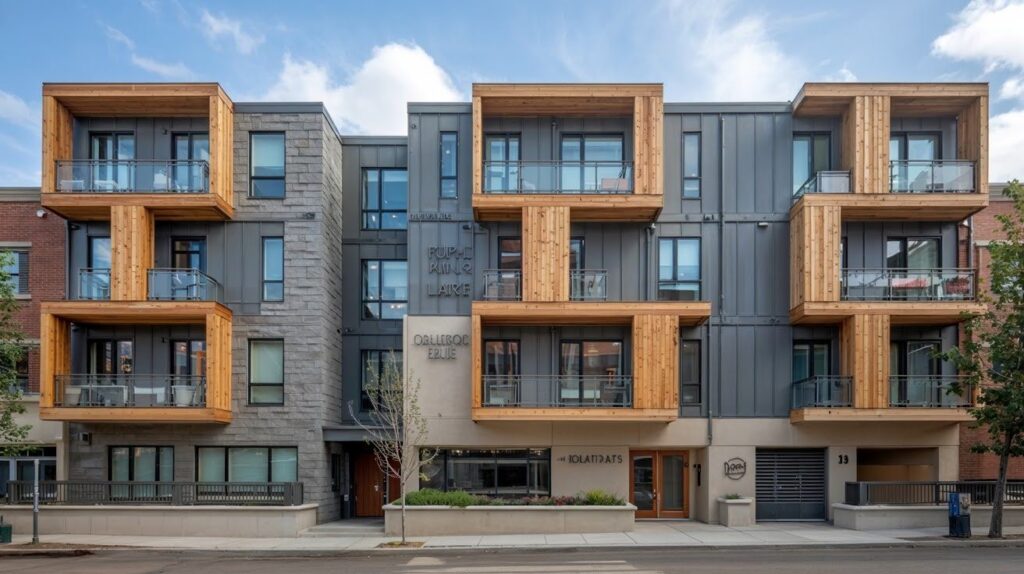
Three-dimensional wood framing elements add sculptural quality to flat building facades while creating interesting shadow patterns throughout the day.
Multiple wood tones and patinas within single installations provide visual complexity that prevents large building surfaces from appearing monotonous or institutional.
Strategic wood placement can emphasize important architectural features like window groupings, entry sequences, or building corners.
The natural texture and warm color of wood draws attention to these elements while softening the hard edges typically found in contemporary construction.
6. Subtle Horizontal Wood Bands Along Rooflines
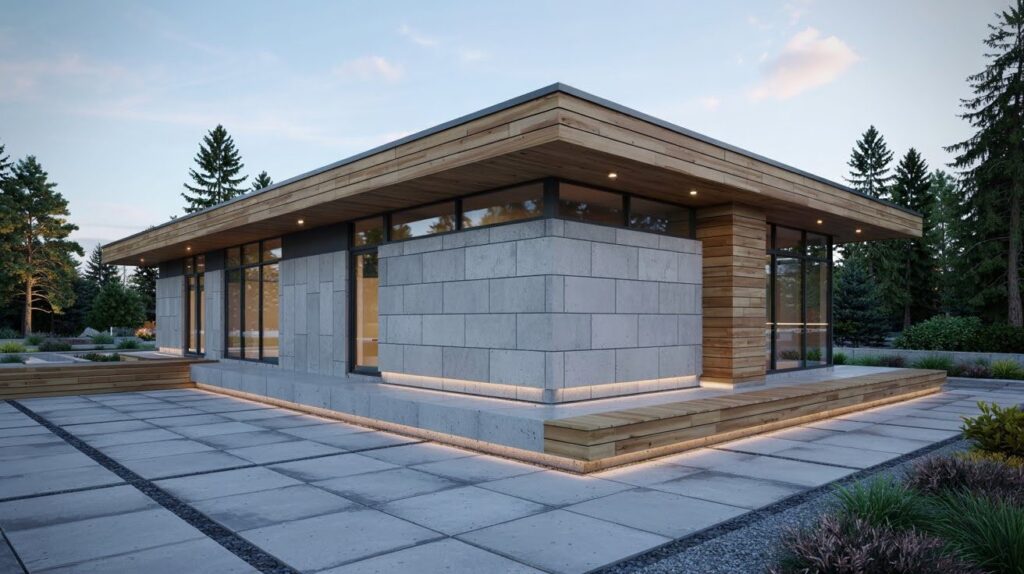
Flat roof homes sometimes lack visual definition at their upper edges, but horizontal wood bands provide clear termination lines that improve overall building proportions.
These elements also create opportunities for integrated lighting or other functional features while adding natural material interest.
Wood soffits and fascia boards create continuous lines that unify different building surfaces and materials.
When executed in consistent wood tones and finishes, these elements provide visual coherence that makes complex architectural compositions feel intentional and well-resolved.
7. Coastal Chic with Reclaimed Driftwood Tones
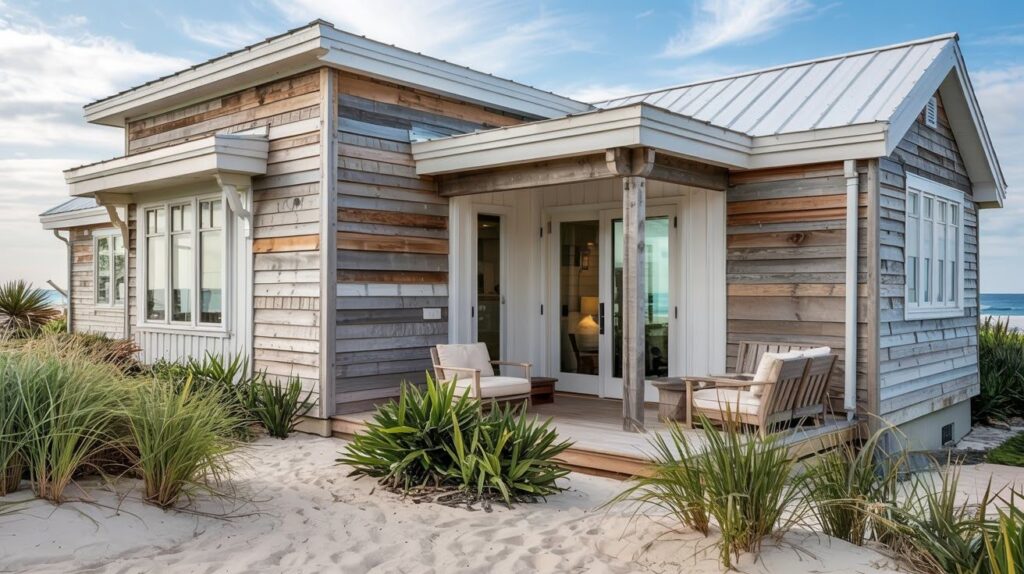
Coastal homes benefit from wood selections that echo natural beach conditions, with silvered driftwood tones providing authentic seaside character.
Combining this aesthetic with sustainable reclaimed materials creates environmentally responsible designs that honor coastal traditions while meeting contemporary performance standards.
Rather than covering entire facades with wood, selective accent walls create focal points that maximize visual impact while controlling material costs.
These statement surfaces work particularly well around entry areas, outdoor living spaces, or prominent architectural features that benefit from enhanced attention.
8. Stylish Yard Structures with Purpose
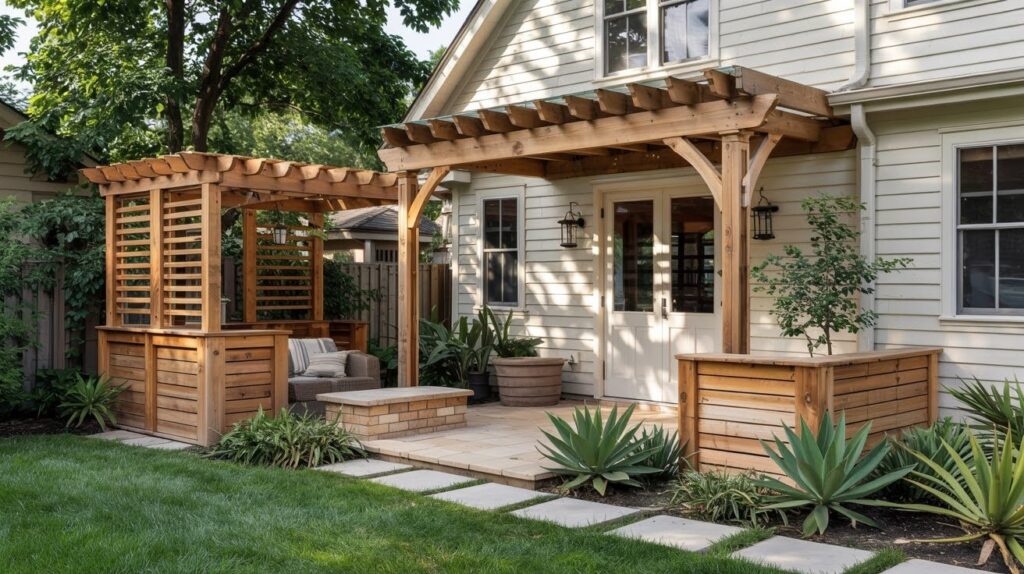
Functional yard structures like privacy screens, utility covers, and storage enclosures become design opportunities when executed in wood materials that complement main building elements.
These structures can hide unsightly equipment while creating attractive backyard features that feel integrated with overall property design.
Detached wood structures like pergolas, pavilions, or decorative screens add natural material presence without requiring modifications to existing buildings.
This approach works particularly well for rental properties or historic homes where permanent alterations might not be feasible or desirable.
9. Mixed Material Masterpiece in the Mountains
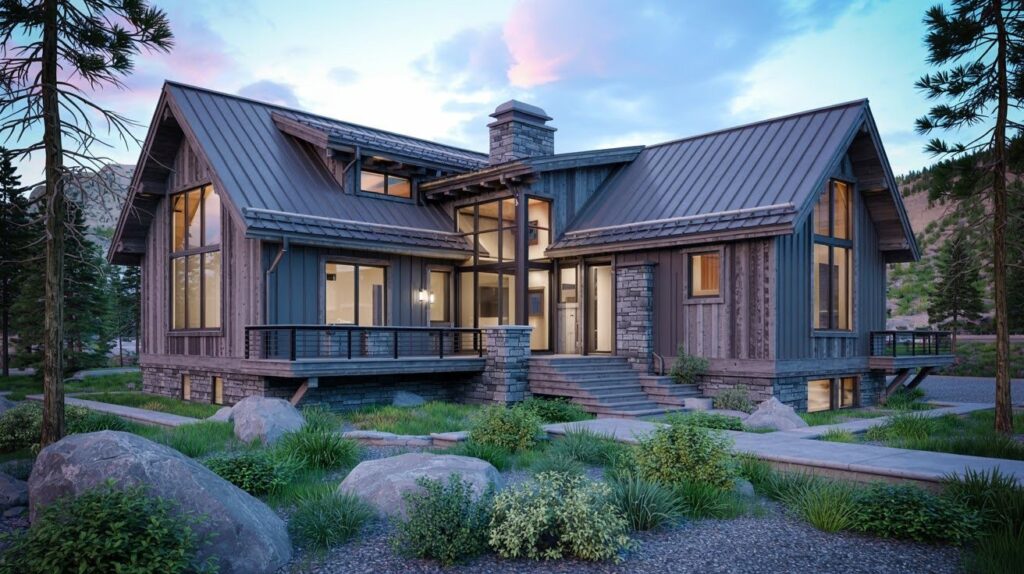
Successful mixed-material designs require careful attention to proportions and color relationships between different elements.
Wood provides essential warmth that balances cooler materials like steel and stone, creating compositions that feel both sophisticated and approachable in mountain settings.
Weathered wood elements provide visual stability in complex material compositions, offering consistent color and texture that ties together more varied elements.
These anchoring details prevent mixed-material facades from appearing chaotic while maintaining design interest and complexity.
10. A Modern Take on a 1950s Ranch Home
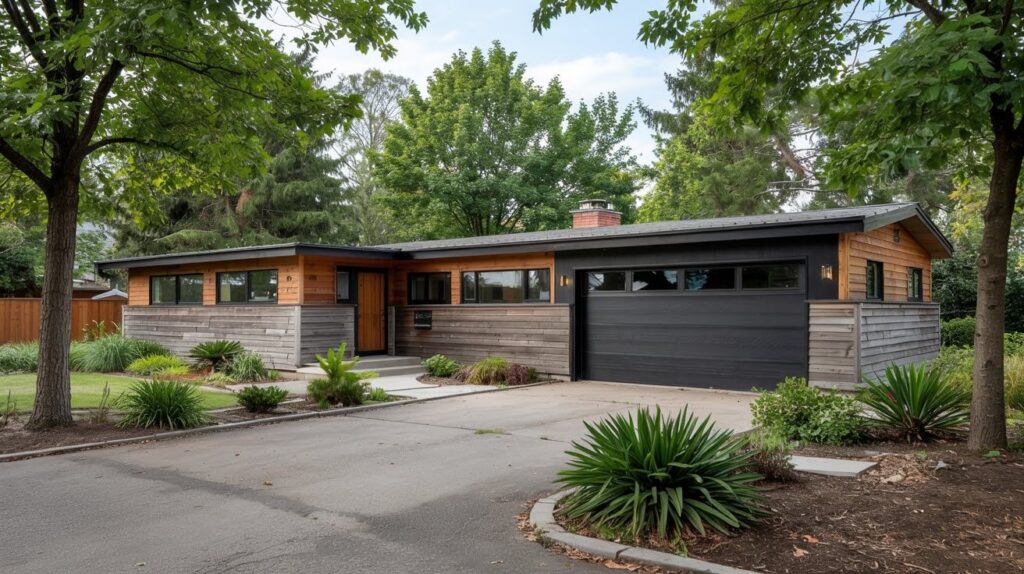
Many mid-century ranch homes feature aluminum siding that can feel dated and sterile.
Replacing or supplementing these surfaces with authentic wood textures immediately updates the home’s appearance while honoring the original architectural intention of clean, horizontal lines.
Contemporary metal garage doors paired with grey wood siding create sophisticated material contrasts that update ranch home aesthetics for current tastes.
This combination maintains the period’s emphasis on horizontal lines while introducing natural textures that add warmth and visual interest.
11. Ceiling Statements: Wood-Clad Overhangs & Lanais
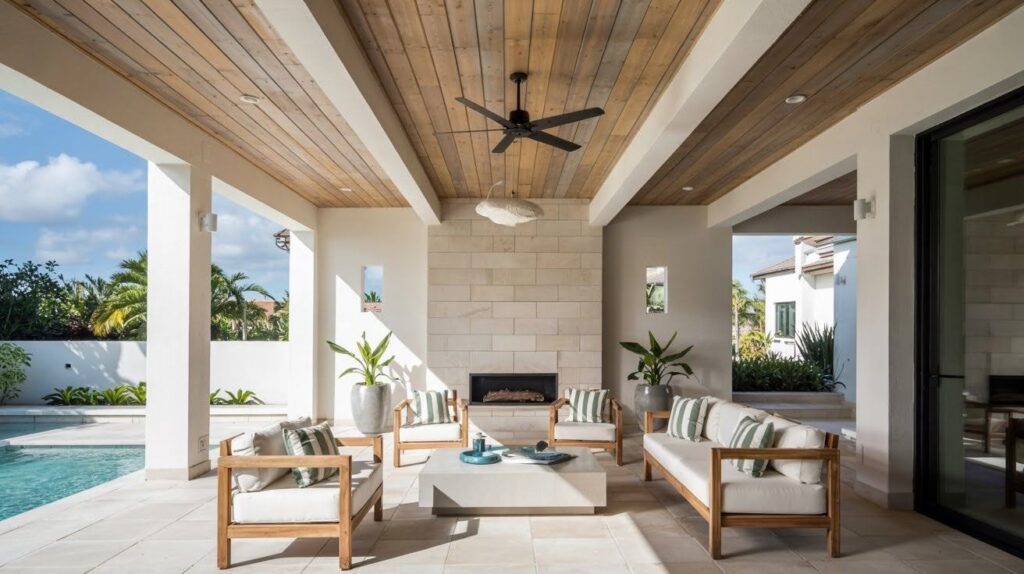
Overhead surfaces often receive little design attention, but wood-clad ceilings in covered outdoor spaces create intimate, room-like qualities that make these areas feel more finished and intentional.
Reclaimed wood brings character and history to these “fifth wall” applications.
Weathered wood finishes on overhead surfaces provide coastal character while working beautifully in modern architectural contexts.
These treatments age gracefully and develop additional patina over time, ensuring the design continues to improve rather than deteriorate with age.
12. Modern Modular Homes with Natural Touches
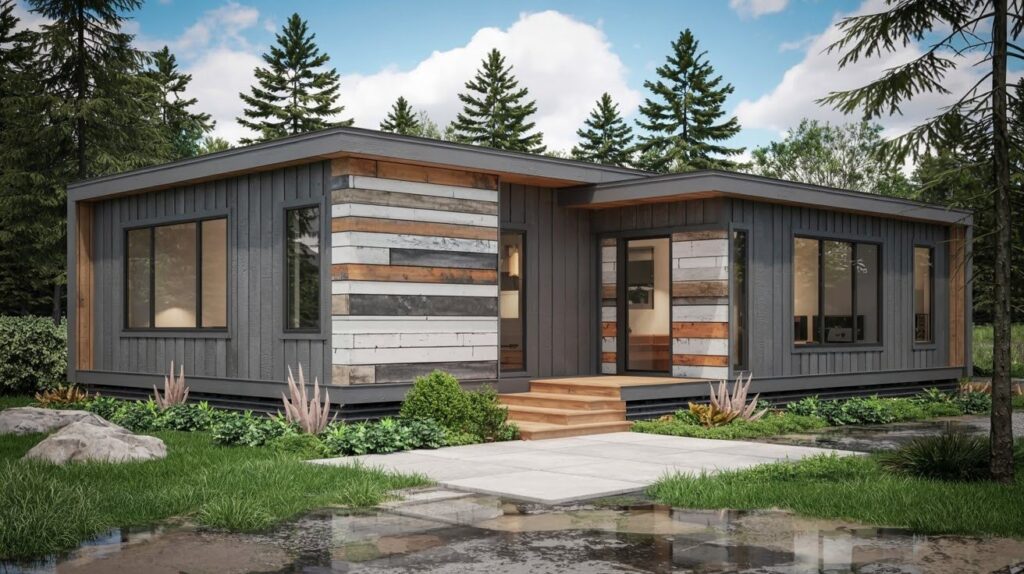
Manufactured and modular homes often suffer from generic appearances that lack character and regional connection.
Strategic additions of reclaimed wood accents can transform these efficient structures into distinctive homes that feel custom-designed and site-specific.
Modern prefab designs sometimes feature bright colors or bold geometric forms that can feel harsh without tempering elements.
Neutral, aged wood tones provide visual balance that allows bold design moves to feel intentional rather than jarring.
13. Framing Glass with Warm Wood Accents
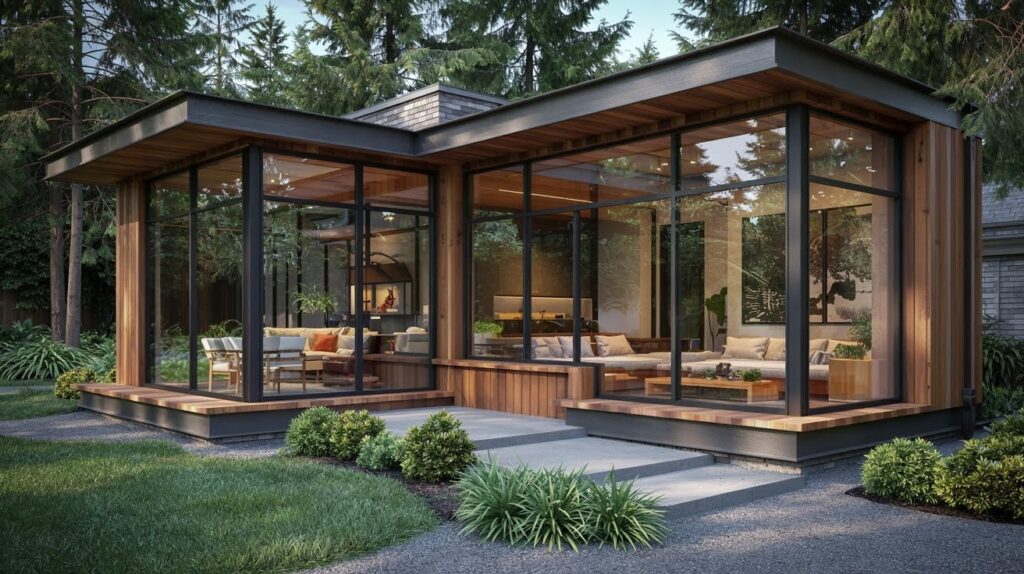
Large glass surfaces are hallmarks of contemporary design, but they can feel cold and institutional without proper material context.
Wood frames, sills, or adjacent accent panels provide human-scaled elements that make expansive glazing feel more approachable and residential.
The contrast between precise glass surfaces and organic wood textures creates compelling visual tensions that define much of contemporary residential design.
This material relationship allows homes to feel both sophisticated and comfortable, balancing high-performance building systems with natural warmth.
Tips for Using Wood Accents in Modern Exterior Design
- Choose climate-appropriate finishes – Coastal areas need moisture resistance, deserts require UV protection, mountains need freeze-thaw durability
- Balance materials – Mix wood with metal, glass, or stone for visual contrast and cohesive design
- Use wood strategically – Focus on key features like entries and accent walls rather than entire surfaces
- Highlight architectural lines – Emphasize rooflines, corners, and structural elements to draw attention to good design
- Maintain regularly – Annual cleaning and periodic staining preserve appearance and structural integrity
- Install properly – Ensure adequate drainage and ventilation to prevent moisture damage
- Match local tones – Select stain colors that complement regional landscape for natural integration
Conclusion
Modern wood accents offer homeowners an exceptional opportunity to create distinctive exteriors that stand out from conventional designs.
The natural texture and varied tones of wood provide visual depth and warmth that transforms ordinary facades into compelling architectural statements.
Each wood species and finish brings unique character, allowing for personalized expressions that reflect individual style preferences.
Reclaimed wood represents the perfect marriage of aesthetic appeal and environmental responsibility.
These materials bring authentic history and weathered beauty to contemporary designs while reducing environmental impact through material reuse.
The distinctive patina and grain patterns found in reclaimed wood cannot be replicated in new materials, ensuring your home’s exterior will possess genuine character that improves with age while supporting sustainable building practices.
Frequently Asked Questions
What types of wood work best for exterior accents?
Cedar, redwood, and ipe offer natural weather resistance and beautiful aging characteristics for exterior applications. Reclaimed wood provides unique character and sustainability benefits, while thermally modified woods offer enhanced durability in challenging climates.
How do I maintain wood accents on my home’s exterior?
Clean wood surfaces annually with mild soap and water to remove dirt and mildew buildup. Apply protective stain or sealant every 2-3 years depending on climate conditions and wood type.
Can wood accents work with any architectural style?
Wood accents adapt beautifully to various styles from modern minimalist to traditional farmhouse designs. The key is selecting appropriate wood tones, textures, and placement that complement your home’s existing architectural character.
How much does it cost to add wood accents to a home exterior?
Costs vary significantly based on wood type, installation complexity, and project scope, typically ranging from $15-50 per square foot. Reclaimed materials may cost more upfront but offer unique character and environmental benefits.
Should I use wood accents sparingly or cover large areas?
Strategic placement creates more dramatic impact than covering entire surfaces while controlling costs effectively. Focus on key architectural features like entries, accent walls, or rooflines for maximum visual effect.

